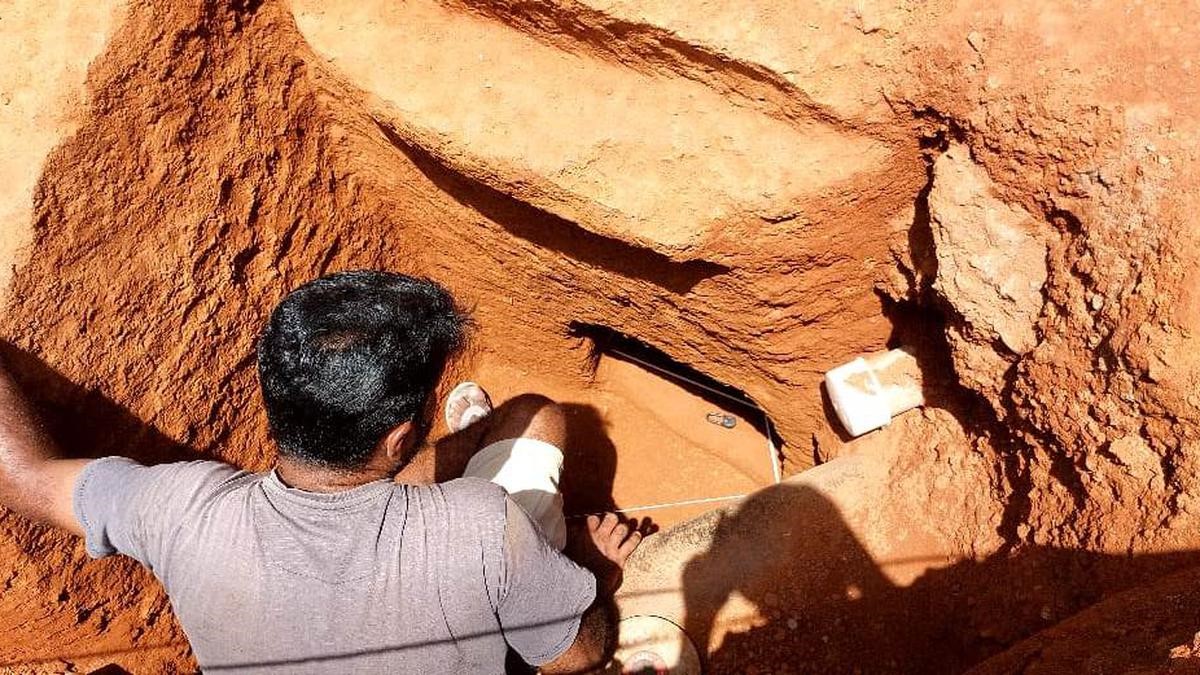Description

Disclaimer: Copyright infringement not intended.
Context
- A recent archaeological salvage excavation conducted by the State Archaeology Department at Nagaparamba, Kuttippuram village, near Tirunavaya, Kerala, has led to the discovery of a large number of megalithic hat stones.
- These findings provide valuable insights into the burial practices and culture of people who lived in the region over 2,000 years ago.
- The presence of these megalithic structures highlights the need for preservation and recognition of the historic significance of Tirunavaya.
Details
Megalithic Hat Stones
- Definition: Hat stones, known as "Thoppikkallu" in Malayalam, are hemispherical laterite stones that were used as lids for burial urns during the megalithic period.
- Archaeological Significance: These hat stones are a crucial archaeological find as they provide insights into the burial rituals, customs, and beliefs of the ancient people.
Salvage Excavation and Discoveries
- Archaeological Salvage Excavation: The recent excavation was prompted by the discovery of a unique rock-cut laterite burial chamber during pipeline work in Nagaparamba.
- Uncovered Relics: The salvage excavation revealed a significant number of megalithic burial sites, earthen urns, and iron implements with distinct features.
- Distinctive Rock-Cut Cave: The architectural features of the rock-cut cave stand out, and the recovered pottery from the site differs from the usual urns found in such megalithic sites.
- Special Ashes: Among the artifacts recovered were ashes found in both the burial chamber and under the hat stones. The ashes are deemed to be of particular significance.

Cultural Insights
- Burial Practices: The discovery of megalithic burial sites and unique artifacts sheds light on the burial practices and rituals of the people who lived in the region during the megalithic period.
- Distinctive Urns: The distinctive features of the urns recovered suggest variations in burial customs and cultural practices.
Local Response and Heritage Status
- Many locals advocate for Tirunavaya to be recognized as a heritage village due to its historic significance. They urge the government to acknowledge the cultural importance of the region.
Understanding Megaliths: Ancient Stone Structures in India
- Megaliths, large stones used to construct prehistoric structures and monuments, provide valuable insights into ancient civilizations and burial practices.
- These stones were either erected individually or in combination with others to create significant structures.
- They can be categorized into two main types: those used for burial purposes and those erected as commemorative memorials.
Types of Megalithic Structures
- Stone Circles (Cromlechs): Circular arrangements of stones, often used as ceremonial or burial sites. The term "cromlech" is sometimes used, with variations in different languages.
- Monoliths: Single standing stones erected in prehistoric times, sometimes used as memorials or markers.
Burial Sites
- Dolmenoid Cists: These are box-shaped stone burial chambers where a large capstone is placed on support stones, forming an enclosed chamber beneath. Often used for burials.
- Cairn Circles: Stone circles with defined peripheries, sometimes enclosing a central burial chamber. They are common burial sites.
- Capstones: Unique mushroom-shaped burial chambers, mainly found in Kerala, often used as tombs.
Burial Containers
- Terracotta Urns: The urns or sarcophagi containing mortal remains were usually made of terracotta and placed within the burial chambers.
Memorial Sites
- Menhirs: These are large single standing stones erected in prehistoric times. They are often used as memorials or markers.
Chronology of Megaliths in India
- Iron Age and Preceding Periods: Most megalithic sites in India are attributed to the Iron Age, dating from 1500 BC to 500 BC. Some sites even predate the Iron Age, extending back to around 2000 BC.
Distribution of Megaliths
- Geographical Spread: Megalithic sites are spread across the Indian subcontinent, with a concentration in Peninsular India.
- States: Notable states with numerous megalithic sites include Maharashtra (particularly in Vidarbha), Karnataka, Tamil Nadu, Kerala, Andhra Pradesh, and Telangana.

Conclusion
Megalithic structures in India offer a glimpse into the rich history of ancient civilizations, their burial practices, and cultural customs. The diversity in megalithic types and their distribution across the Indian subcontinent emphasize the need for their preservation and thorough study. These stone monuments serve as windows into the past, shedding light on the traditions and societies that existed thousands of years ago.
|
PRACTICE QUESTION
Q. Discuss the significance of megalithic structures in India's archaeological landscape. How do these structures provide insights into ancient burial practices, cultural customs, and societal beliefs? (250 Words)
|
https://www.thehindu.com/sci-tech/science/hat-stones-in-abundance-at-archaeology-site-near-tirunavaya/article67210231.ece















